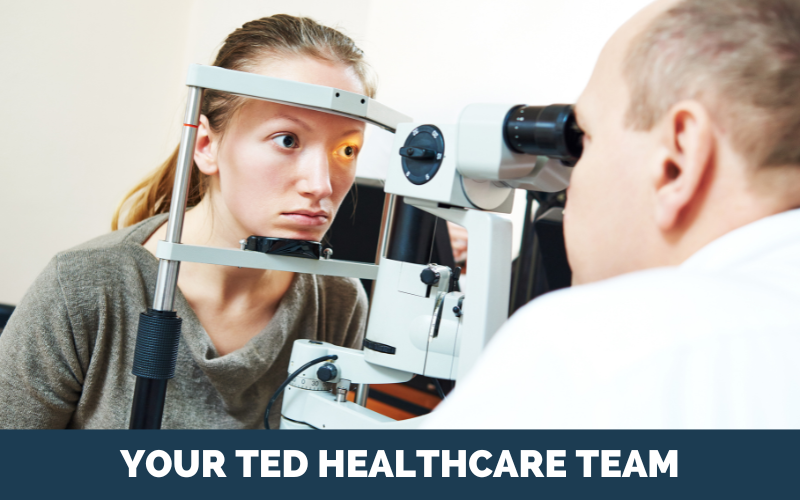Thyroid Eye Disease
Thyroid eye disease treatments
Your current treatment options
If you think you have symptoms of thyroid eye disease, it is important to get diagnosed and treated early. We take you through these processes and options.
If you experience symptoms such as red, watery, burning or dry eyes, retracted or inflamed eyelids or blurry or double vision it is important to see your GP as soon as possible. If you see an endocrinologist or rheumatologist for an existing autoimmune condition or see an optometrist for general vision issues, you can also mention your concerning symptoms to them.
If they suspect you may have a serious eye condition, such as thyroid eye disease (TED), they will likely refer you to an ophthalmologist (eye specialist) for further investigation. Because TED (also called Graves’ eye disease) is an immune system disorder, it generally won’t go away (and stay away) on its own. Effective TED treatment can relieve not only symptoms but underlying inflammation that can cause other serious problems over time. Therefore, it is important to get an accurate diagnosis and begin treatment urgently.
Your doctor or optometrist can start you on basic treatments to relieve your symptoms while waiting for a diagnosis.
Your healthcare team will include your ophthalmologist and GP and may include an endocrinologist, rheumatologist, radiologist, optometrist, occupational therapist, psychologist and others. Your treatment will be based on your individual needs.
You may need to modify some aspects of your lifestyle to help improve your chance of successful outcomes. For example:
- If you are a smoker, avoiding or stopping smoking can greatly decrease your chances of developing severe TED symptoms and possible eye damage.
- Using cool compresses over your eyes and elevating your head when sleeping can help reduce fluid build-up and pressure in your eyes.
- Wearing sunglasses can help manage light sensitivity and hide your eye changes from others if that unsettles you.
In mild cases of TED, it could be good to buy eye drops, gels and ointments that can help relieve dryness and irritation. These treatments can typically be bought over the counter. Ask your doctor or pharmacy staff about the most suitable products for you. Other treatments may include:
- Selenium supplements: Selenium is an antioxidant that can help reduce soft tissue swelling.
- Thyroid medications: It is important to treat underlying thyroid conditions, such as Graves’ disease or Hashimoto’s disease while undergoing treatment for TED. As TED is a separate (but usually related) condition, it requires its own treatment course.
- Prism glasses: Persistent double vision can be managed with plastic prism lenses added to vision glasses. If your eyes are misaligned, they don’t focus on the same spot. Prism lenses compensate for this by redirecting light from each eye to the correct spot on your retina so you see the left and right images aligned. If your issue is long-term, your prisms can be built into your lenses.
It is important to note that for most people with TED, symptoms do not progress beyond this stage.
If your vision and/or physical symptoms are getting worse, you will likely need stronger treatment. This includes treatments to reduce the swelling and suppress the immune system. Your doctors may recommend any of the following treatments depending on your needs. Some of these treatments may be used in conjunction with each other.
Steroid therapy
Steroids are used for a wide range of conditions, including autoimmune arthritis, asthma, allergies and tumours. Those with moderate disease may be offered steroids in oral form. Steroids are very effective for treating inflammation and soft tissue symptoms but are often not effective in addressing double vision and eye protrusion. However, they can also cause side effects like elevated blood sugar, high blood pressure, weight gain, sleeplessness and thinning of the bones, especially if used at high doses or over long periods.
If you have active vision-threatening disease you will likely be given a weekly or fortnightly infusion of steroids (methylprednisolone) at a high dose. During the course of your treatment, your responses will be monitored closely with the benefits weighed up against the severity of any side effects. If your symptoms have improved, your course of infusions will be stopped and your symptoms will continue to be monitored. You may need another course of steroid infusions if your symptoms return.
Radiation therapy
For some people, low-dose radiation therapy may be offered instead of, or along with, steroid therapy. This involves the use of targeted radiation beams to your eye from outside your body. The treatment aims to reduce inflammation while other symptoms and side effects are generally minimal.
Once the thyroid eye disease reaches a stable uninflamed state, these treatments are not effective.
Immune system therapy
If steroid therapy has not worked well enough for you, you might be offered an immunotherapy medicine. These work by targeting and regulating parts of your immune system and reducing inflammation. They can slow or even stop disease progression whereas the treatments mentioned above only treat symptoms. Immunotherapy can be used instead of or as well as steroids.
Oral immunotherapy medicines commonly used for TED include mycophenolate, cyclosporin (also spelled ciclosporin or cyclosporine) and azathioprine.
Another way your immune system can be helped is via intravenous immunoglobulin, which is an infusion to boost low antibodies.
Biologic immunotherapy therapy
Biologic medications (often simply called “biologics”) target specific parts of the immune system. They are derived from living cells and are administered via subcutaneous injection or intravenous infusion.
The biologic teprotumumab was approved for use in Australia by the Therapeutic Goods Administration (TGA) in April 2025 to treat TED. It is currently being considered by the Pharmaceutical Benefits Advisory Committee (PBAC) for subsidised access via the Pharmaceutical Benefits Scheme (PBS).
Two other biologics can be used here to treat TED here in some circumstances; however, they were not developed specifically for TED. Rituximab is approved for use without restriction on the PBS for many forms of autoimmune diseases that do not otherwise have approved therapeutic options. Tocilizumab is only approved for specific conditions, such as rheumatoid arthritis and giant cell arteritis, but it can sometimes be used off-label for other conditions.
Surgical procedures may be offered to improve lasting appearance, comfort and double vision issues. They are usually performed after the active phase as your treatments may have been enough to address most symptoms. Surgeries can also be performed while you continue to use other treatments.
There are three main types of surgery offered to those with moderate to severe TED.
- Orbital decompression: This is generally used to correct bulging eyes and relieve potentially damaging pressure behind the eye. It involves the removal of orbital bone, fat or both. It can be performed during the active phase of TED if you are in danger of rapid or severe eye deterioration and/or loss of vision. However, with advancements in medical treatments for TED, there is a good chance you may not need emergency decompression surgery.
- Strabismus surgery: If you have misaligned or crossed eyes (strabismus) that haven’t improved with other treatments, you may need eye muscle surgery. This involves moving some of your eye muscles to realign your eyes.
- Eyelid surgery: If your eyelids cannot close properly, your eyes can become very dry and potentially infected. It may also look as though you are constantly staring. Eyelid surgery can correct this issue and protect your eye.
These procedures are offered in the above order as decompression may cause eye misalignment and strabismus surgery can affect eyelid position.
While the visual and physical symptoms of TED can have a profound effect on your mental state, it is important to know that these symptoms can be treated successfully and surgery can help return your eyes to normal.
If this content has raised feelings that concern you, you can contact:
- Lifeline: lifeline.org.au or call 13 11 14
- Beyond Blue: beyondblue.org.au or call 1300 22 4636
This information should never replace the information and advice from your treating doctors. It is meant to inform the discussion that you have with healthcare professionals, as well as others who play a role in your care and well-being.
Bartalena L, et al. The 2021 European Group on Graves’ Orbitopathy (EUGOGO) clinical practice guidelines for the medical management of Graves’ orbitopathy. Eur J Endocrinol. 2021 Aug 27;185(4):G43-G67. doi: 10.1530/EJE-21-0479. PMID: 34297684. https://pubmed.ncbi.nlm.nih.gov/34297684
British Thyroid Foundation: Your Guide to Thyroid Eye Disease. https://www.btf-thyroid.org/thyroid-eye-disease-leaflet
Burch H, et al. Management of thyroid eye disease: a Consensus Statement by the American Thyroid Association and the European Thyroid Association. European Thyroid Journal. 2022 Dec;8. Doi:10.1530/ETJ-22-0189. https://etj.bioscientifica.com/view/journals/etj/11/6/ETJ-22-0189.xml
Dr Richard Parker: Thyroid Eye Disease Surgery. https://www.drrichardparker.com.au/conditions-procedures/thyroid-eye-surgery
Endocrine Society: Patient Resources – Thyroid Eye Disease. https://www.endocrine.org/patient-engagement/endocrine-library/thyroid-eye-disease
Eye Surgery Consultants: Thyroid Eye Disease. https://eyesurgeryconsultants.com.au/thyroid-eye-disease
Fung S, Malhotra R, Selva D. Royal Australian College of General Practitioners: Clinical Practice: Therapeutic review – Thyroid orbitopathy. https://www.racgp.org.au/getattachment/e10a3bd8-a800-4a53-8635-1bf0764912d6/attachment.aspx
Hall AJH, Topliss DJ. Medical and surgical treatment of thyroid eye disease. Intern Med J. 2022 Jan;52(1):14-20. doi: 10.1111/imj.15067. PMID: 32975863. https://pubmed.ncbi.nlm.nih.gov/32975863
Healthdirect: Azathioprine (Sandoz TM). https://www.healthdirect.gov.au/medicines/brand/amt,920084011000036104/azathioprine-sandoz
Healthdirect: Cyclosporin (Sandoz TM). https://www.healthdirect.gov.au/medicines/brand/amt,58081000036102/cyclosporin-sandoz
Healthdirect: Mycophenolate (Sandoz TM). https://www.healthdirect.gov.au/medicines/brand/amt,1041000036107/mycophenolate-sandoz
Immunotherapies for autoimmune diseases. Nat Biomed Eng 3, 247. 2019 April. https://www.nature.com/articles/s41551-019-0394-3
Medical Republic: Diagnosis and management of thyroid eye disease. 2021 February 2. https://www.medicalrepublic.com.au/diagnosis-and-management-of-thyroid-eye-disease/4800
Modern Optometry: What You Need to Know to Manage TED. 2022 July/August. https://modernod.com/articles/2022-july-aug/what-you-need-to-know-to-manage-ted?c4src=article:infinite-scroll
Penn Medicine News: The Immunotherapy Revolution for Autoimmune Diseases. 2023 August 12. https://www.pennmedicine.org/news/publications-and-special-projects/penn-medicine-magazine/immune-health/the-immunotherapy-revolution-for-autoimmune-diseases
Queensland Eye Institute: Eye Conditions – Thyroid Eye Disease (TED). https://qei.org.au/eye-conditions/thyroid-eye-disease/
The Royal Eye and Ear Hospital: Clinical Practice Guideline – Emergency Department Thyroid-Associated Orbitopathy. https://eyeandear.org.au/wp-content/uploads/2021/11/Thyroid-Associated-Orbitopathy-Clinical-Practice-Guideline.pdf
Radiation Oncology: Targeting Cancer. Thyroid Eye Disease. https://www.targetingcancer.com.au/treatment-by-cancer-type/thyroid-eye-disease
Rheumatology Republic: Let the Rituximab Flow. 2022 September 1. https://www.rheuma.com.au/let-the-rituximab-flow/1090




